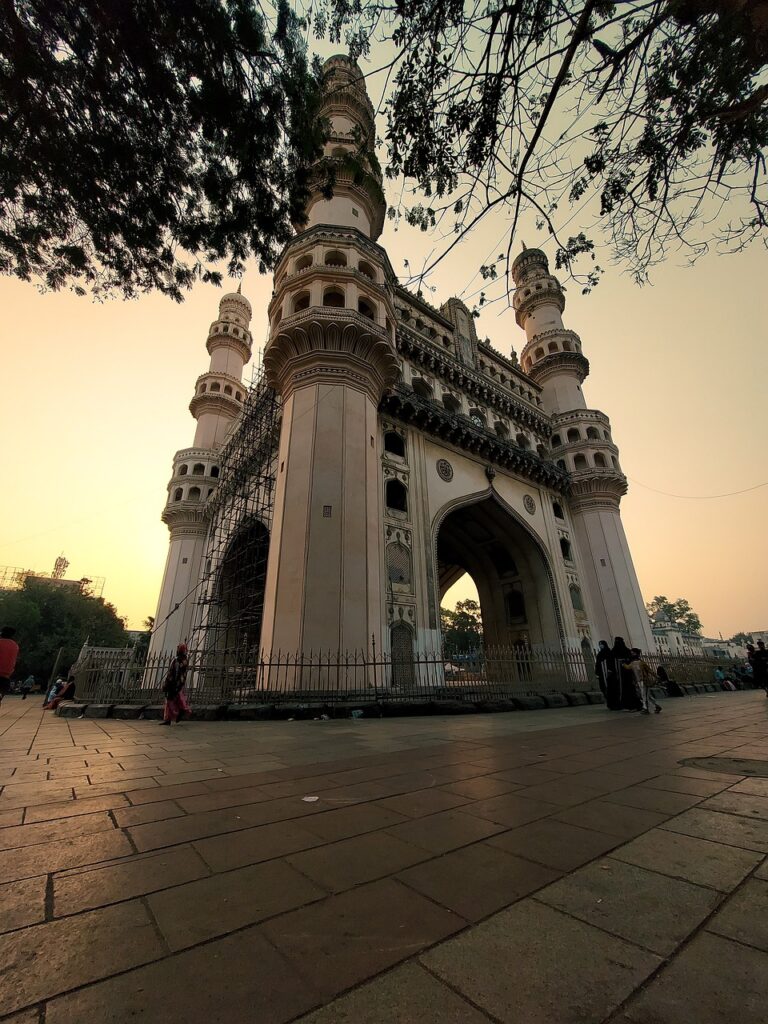The Charminar is an iconic monument located in the city of Hyderabad, in the southern part of India. It is one of the most well-known landmarks in the country, known for its historical significance, architectural beauty, and cultural importance. Here’s more about it:
1. History and Origin
- Construction Date: The Charminar was built in 1591 by Muhammad Quli Qutb Shah, the fifth Sultan of the Qutb Shahi dynasty, in the heart of the old city of Hyderabad.
- Purpose: The monument was constructed to mark the founding of the city of Hyderabad and to commemorate the end of a deadly plague that had affected the region. The name “Charminar” literally means “four minarets,” referring to the structure’s four grand arches, each facing a different direction.
2. Architecture
- Design: The Charminar is a square-shaped structure with four grand arches, each of which opens up to a street. The minarets rise to a height of about 56 meters (183 feet).
- Structure: The monument is made of granite and lime mortar, and it has a blend of Islamic and Persian architectural styles, with influences from Indo-Saracenic design.
- Four Minarets: The four minarets of the Charminar are each adorned with beautiful arches and intricate carvings, with the central dome positioned at the top. The design incorporates Islamic, Persian, and Hindu elements, symbolizing the cultural fusion of the period.
3. Significance
- Cultural Hub: The Charminar is located at the center of a bustling market area known as Laad Bazaar, which is famous for selling pearls, jewelry, and traditional Hyderabadi crafts.
- Religious Importance: The monument is also significant for its association with the Islamic culture and is a symbol of the city’s Islamic heritage. There is a mosque on the top floor of the Charminar, which is still in use today.
- Symbol of Hyderabad: The Charminar is considered the symbol of Hyderabad, and it’s featured in many images representing the city. It is often used for tourism promotion and city branding.
4. Visiting Charminar
- Tourist Attraction: The Charminar is a major tourist destination, drawing visitors from around the world. The structure is particularly beautiful at night when it is illuminated.
- Nearby Attractions: The Charminar is situated near other important attractions like the Chowmohalla Palace, Mecca Masjid, and Salar Jung Museum, making it a key stop for anyone exploring the historical side of Hyderabad.
- Preservation: Over the centuries, the Charminar has undergone several restoration efforts to maintain its original grandeur, and it continues to stand as one of India’s most recognizable monuments.
5. Legends and Folklore
- Origin of the Name: According to some local legends, the Charminar was built to commemorate a prayer for the city’s protection from the plague. Another folklore suggests that the Sultan vowed to build the Charminar as a mark of thanks after the end of the disease.
- Haunted Tales: Some myths claim that the monument is haunted, with tales of mysterious occurrences within the structure.
6. Modern-Day Relevance
- The Charminar stands as both a historical monument and a living part of the city of Hyderabad. It is a focal point for the city’s cultural and social life, and it represents the fusion of the old and new, with modern markets surrounding it while the monument itself retains its ancient charm.
In short, the Charminar is a symbol of Hyderabad’s rich history, architectural grandeur, and cultural legacy. It continues to be a place of historical pride and a bustling tourist attraction in the heart of the city.

Lorem ipsum dolor sit amet, consectetur adipiscing elit. Ut elit tellus, luctus nec ullamcorper mattis, pulvinar dapibus leo.
Lorem ipsum dolor sit amet, consectetur adipiscing elit. Ut elit tellus, luctus nec ullamcorper mattis, pulvinar dapibus leo.
